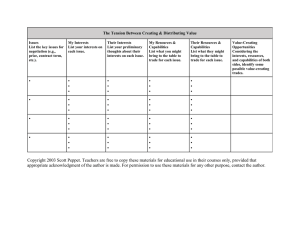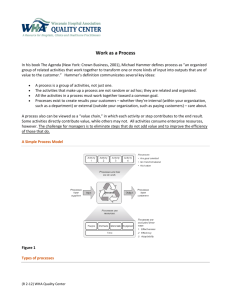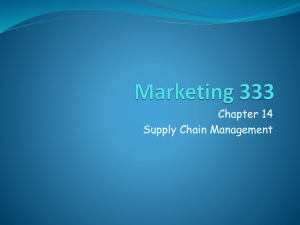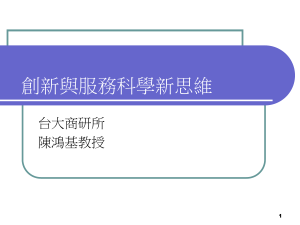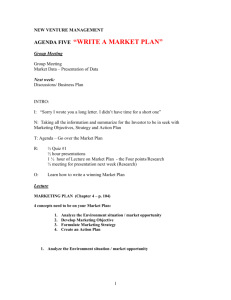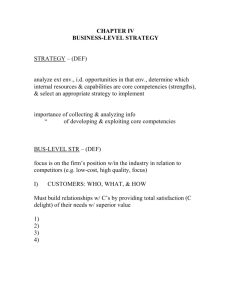Internal Analysis
advertisement
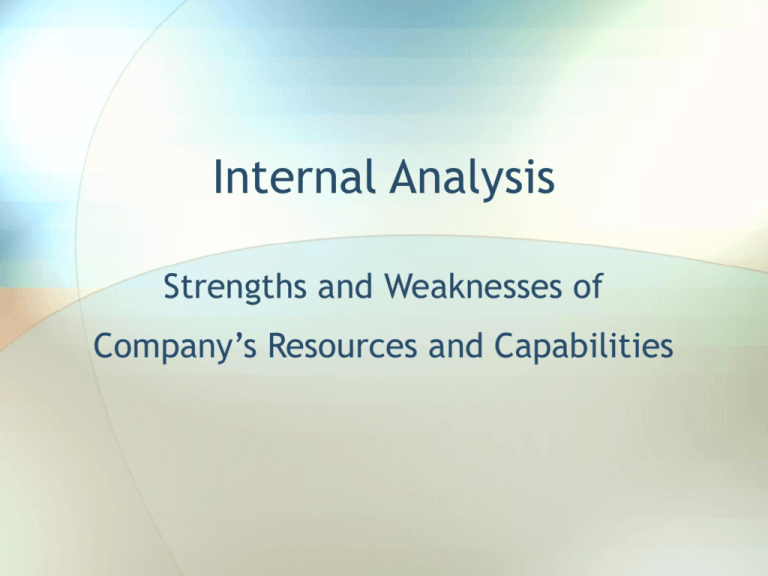
Internal Analysis Strengths and Weaknesses of Company’s Resources and Capabilities Outcomes from External and Internal Environmental Analyses Examine opportunities and threats Examine unique resources, capabilities, and competencies (sustainable competitive advantage) Tools for Building Competitive Advantage • Resources are inputs into a firm’s production processes: Tangible Resources Financial resources Physical resources Technological resources Organizational resources Intangible Resources Human resources Innovative resources Reputation • Capabilities are the capacity for a set of resources to integratively perform a task or activity Resources − Are the source of a firm’s capabilities − Are broad in scope − Cover a spectrum of individual, social and organizational phenomena − Alone, do not yield a competitive advantage Tangible Resources • Technological Resources •Stock of technology, such as patents, trade-marks, copyrights, and trade secrets • Financial Resources • The firm’s borrowing capacity • The firm’s ability to generate internal funds • Organizational Resources • The firm’s formal reporting structure and its formal planning, controlling, and coordinating systems • Physical Resources • Sophistication and location of a firm’s plant and equipment • Access to raw materials Intangible Resources • Human Resources • Knowledge • Trust • Managerial capabilities • Organizational routines • Innovation Resources • Ideas • Scientific capabilities • Capacity to innovate • Reputational Resources • Reputation with customers • Brand name • Perceptions of product quality, durability, and reliability • Reputation with suppliers • For efficient, effective, supportive, and mutually beneficial interactions and relationships Capabilities − Are the firm’s capacity to deploy resources that have been purposely integrated to achieve a desired end state − Emerge over time through complex interactions among tangible and intangible resources − Often are based on developing, carrying and exchanging information and knowledge through the firm’s human capital − Capabilities are often developed in specific functional areas or as part of a functional area − The foundation of many capabilities lies in: • The unique skills and knowledge of a firm’s employees • The functional expertise of those employees Examples of Firms’ Capabilities Core Competencies − Resources and capabilities that serve as a source of a firm’s competitive advantage: • Distinguish a company competitively and reflect its personality • Emerge over time through an organizational process of accumulating and learning how to deploy different resources and capabilities − Activities that a firm performs especially well compared to competitors − Activities through which the firm adds unique value to its goods or services over a long period of time The Four Criteria of Sustainable Competitive Advantage • Valuable Capabilities • do a firm’s resources and capabilities allow a firm to respond to its environment? • Rare Capabilities • how many rival firms already possess this resource/capability? • Costly-to-Imitate Capabilities • do firms face a cost disadvantage in obtaining this resource/capability compared to firms that already have it? • Non-substitutable Capabilities • • are there strategic alternatives? Cost Disadvantages of Imitation • Inimitability is critical for a resource/capability to be a core competence • Firms trying to imitate another firm’s core competence are at a cost disadvantage relative to rivals due to − Historical: A unique and a valuable organizational culture or brand name − Ambiguous cause: The causes and uses of a competence are unclear − Social complexity: Interpersonal relationships, trust, and friendship among managers, suppliers, and customers − Patents Value Chain Analysis • Allows the firm to understand the parts of its operations that create value and those that do not • A template that firms use to: − Understand their cost position − Identify multiple means that might be used to facilitate implementation of a chosen business-level strategy Value Chain Analysis (cont’d) • Primary activities involved with: − A product’s physical creation − A product’s sale and distribution to buyers − The product’s service after the sale • Support activities − Provide the support necessary for the primary activities to take place Value Chain Analysis (cont’d) • Value chain − Shows how a product moves from raw-material stage to the final customer • To be a source of competitive advantage, a resource or capability must allow the firm: − To perform an activity in a manner that is superior to the way competitors perform it, or − To perform a value-creating activity that competitors cannot complete Service Marketing and Sales Procurement Technological Development Human Resource Management Firm Infrastructure The Basic Value Chain Outbound Logistics Operations Inbound Logistics The Value-Creating Potential of Primary Activities • Inbound logistics − Activities used to receive, store, and disseminate inputs to a product (materials handling, warehousing, inventory control, etc.) • Operations − Activities necessary to convert the inputs provided by inbound logistics into final product form (machining, packaging, assembly, etc.) • Outbound logistics − Activities involved with collecting, storing, and physically distributing the product to customers (finished goods warehousing, order processing, etc.) The Value-Creating Potential of Primary Activities (cont’d) • Marketing and sales − Activities completed to provide means through which customers can purchase products and to induce them to do so (advertising, promotion, distribution channels, etc.) • Service − Activities designed to enhance or maintain a product’s value (repair, training, adjustment, etc.) Each activity should be examined relative to competitors’ abilities and rated as superior, equivalent or inferior The Value-Creating Potential of Primary Activities: Support • Procurement − Activities completed to purchase the inputs needed to produce a firm’s products (raw materials and supplies, machines, laboratory equipment, etc.) • Technological development − Activities completed to improve a firm’s product and the processes used to manufacture it (process equipment, basic research, product design, etc) • Human resource management − Activities involved with recruiting, hiring, training, developing, and compensating all personnel The Value-Creating Potential of Primary Activities: Support (cont’d) • Firm infrastructure − Activities that support the work of the entire value chain (general management, planning, finance, accounting, legal, government relations, etc.) • Effectively and consistently identify external opportunities and threats • Identify resources and capabilities • Support core competencies Each activity should be examined relative to competitors’ abilities and rated as superior, equivalent or inferior Building Blocks of Competitive Advantage Efficiency Lower Costs Quality Innovation Higher Prices Customer Responsiveness Competitive Advantage via Efficiency Manufacturing Econ of scale/learning Flexible manufacturing Marketing Price for learning Build brand loyalty Infrastructure Human Resources Commitment to efficiency Train skills/teams Performance incentives R&D Design for manufacturing Process innovation Materials mgt. JIT, Kanban, etc. Competitive Advantage via Quality Manufacturing Trace defects to source Input from employees Marketing Focus on customer Customer feedback on quality Infrastructure Measure & commit to quality Human Resources Train quality (TQM, SPC) Quality incentives R&D Design for manufacturing Process & product innovation Materials mgt. Help suppliers implement TQM Outsourcing • The purchase of a value-creating activity from an external supplier − Few organizations possess the resources and capabilities required to achieve competitive superiority in all primary and support activities • By forming and emphasizing fewer capabilities − A firm can concentrate on those areas in which it can create value − Specialty suppliers can perform outsourced capabilities more efficiently Strategic Rationales for Outsourcing • Improve business focus − Lets a company focus on broader business issues by having outside experts handle various operational details • Provide access to world-class capabilities − The specialized resources of outsourcing providers makes world-class capabilities available to firms in a wide range of applications • Accelerate business re-engineering benefits − Achieves re-engineering benefits more quickly by having outsiders— who have already achieved world-class standards—take over process • Sharing risks − Reduces investment requirements and makes firm more flexible, dynamic and better able to adapt to changing opportunities • Frees resources for other purposes − Redirects efforts from non-core activities toward those that serve customers more effectively Outsourcing Issues • Greatest value − Outsource only to firms possessing a core competence in terms of performing the primary or supporting the outsourced activity • Evaluating resources and capabilities − Do not outsource activities in which the firm itself can create and capture value • Environmental threats and ongoing tasks − Do not outsource primary and support activities that are used to neutralize environmental threats or to complete necessary ongoing organizational tasks • Non-strategic team of resources − Do not outsource capabilities that are critical to the firm’s success, even though the capabilities are not actual sources of competitive advantage • Firm’s knowledge base − Do not outsource activities that stimulate the development of new capabilities and competencies Cautions and Reminders • Never take for granted that core competencies will continue to provide a source of competitive advantage • All core competencies have the potential to become core rigidities • Core rigidities are former core competencies that now generate inertia and stifle innovation • Determining what the firm can do through continuous and effective analyses of its internal environment increases the likelihood of long-term competitive success
